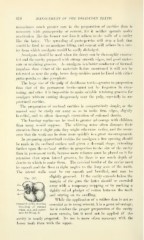Page 678 - My FlipBook
P. 678
676 MANAGEMENT OF THE DECIDUOUS TEETH.
necessitates much oreator care in the jji-cparation of cavities than is
necessary with trutta-percha or cement, for it iicitlicr s|)rea
like the latter. The spreadin^y of ^utta-]iercha will stop a leak that
would be fatal to an amalgam filling, and cement will adhere in a cav-
ity from which amalgam would be easily dislodged.
Amalgam should be used w^hen the decay can be thoroughly excava-
ted and the cavity prepared with strong smooth edges, and good under-
cuts or retaining grooves. As amalgam is a better conductor of thermal
impulses than either of the materials before mentioned it will not be
tolerated so near the pulp, hence deep cavities must be lined with either
gutta-percha or zinc }>hosphate.
The large size of the pul[) of (hn-iduous teeth — greater in proportion
than that of the permanent teeth—must not be forgotten in exca-
vating, and often it is impossible to make suitable retaining grooves for
amalgam without cutting dangerously near the pulp, es])ecially in ap-
proximal cavities.
The preparation of occlusal cavities is comparatively siui])le, as the
enamel may be easily cut away so as to make firm edges, slightly
bevelled, and to allow thorough excavation of softened dentin.
The burring engine can be used to greater advantage with children
than many would suppose. The whirring noise often distracts their
attention from a slight jxiin they might otherwise notice, and the assur-
ance that the work can be done more cpiickly is a great encouragement.
In preparing approximal cavities for amalgam a free opening should
be made in the occlusal surface and given a dovetail shape, extending
farther upon the occlusal surface in proportion to the size of the cavity
than in permanent teeth, because more reliance must be placed on it for
retention than upon lateral grooves, for there is not much depth of
dentin in which to make them. The cervical border of the cavity must
be smooth and the floor at right angles to the long axis of the tooth.
The lateral walls must be cut smooth and Ijevelled, and may be
slightly grooved. If the cavity extends below the
margin of the gum the latter should be crowded
away with a tem})orary stopping or by packing a
tightly rolled pledget of cotton between the teeth
and relying on its swelling.
While the application of a rubber dam is not as
Prepared cavity showing essential as in using cement, it is a great advantage,
beveUing of enamel „ .^ i ii ' a- r ^u v
edges, A,A, and square for it renders the proper preparation ot the cavity
base for fining, B.
^^^^e certain, but it need not be applied till the
cavity is nearly prepared. Its use is more often necessary with the
lower teeth than with the upper.


